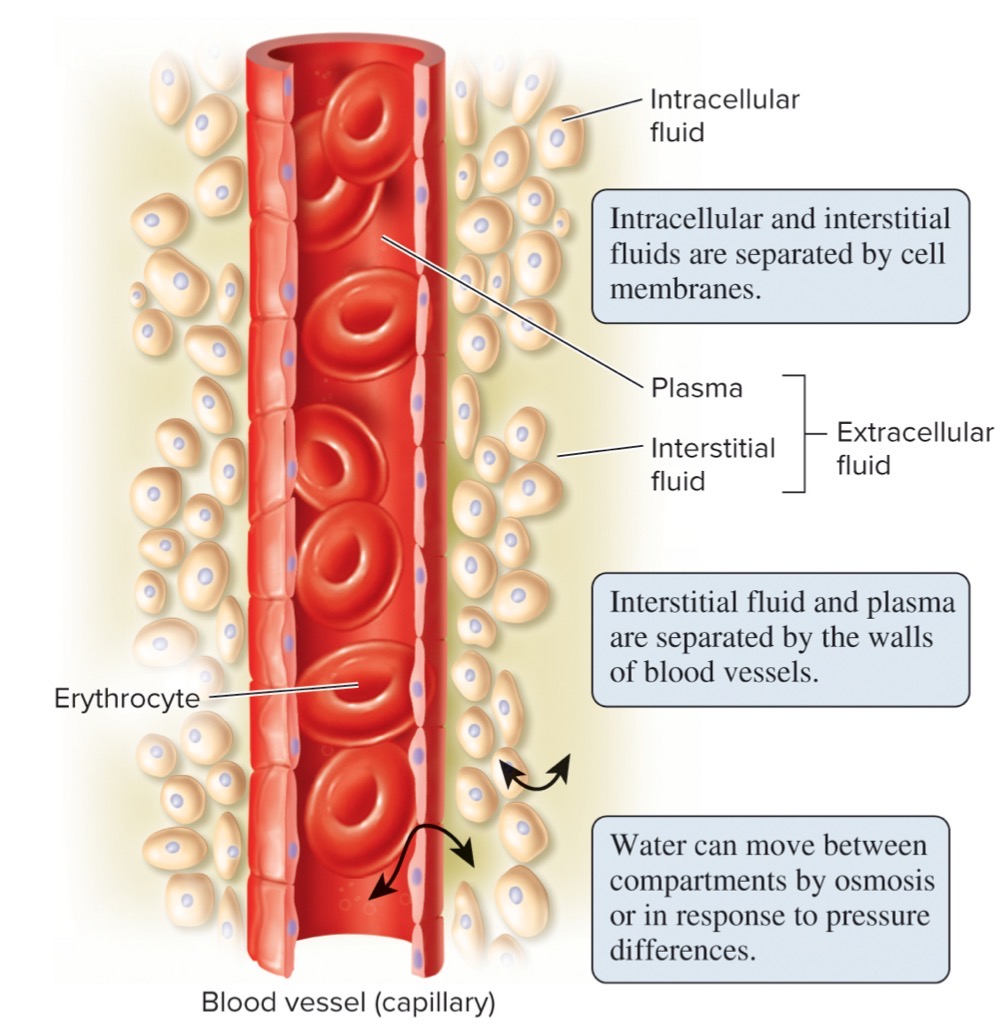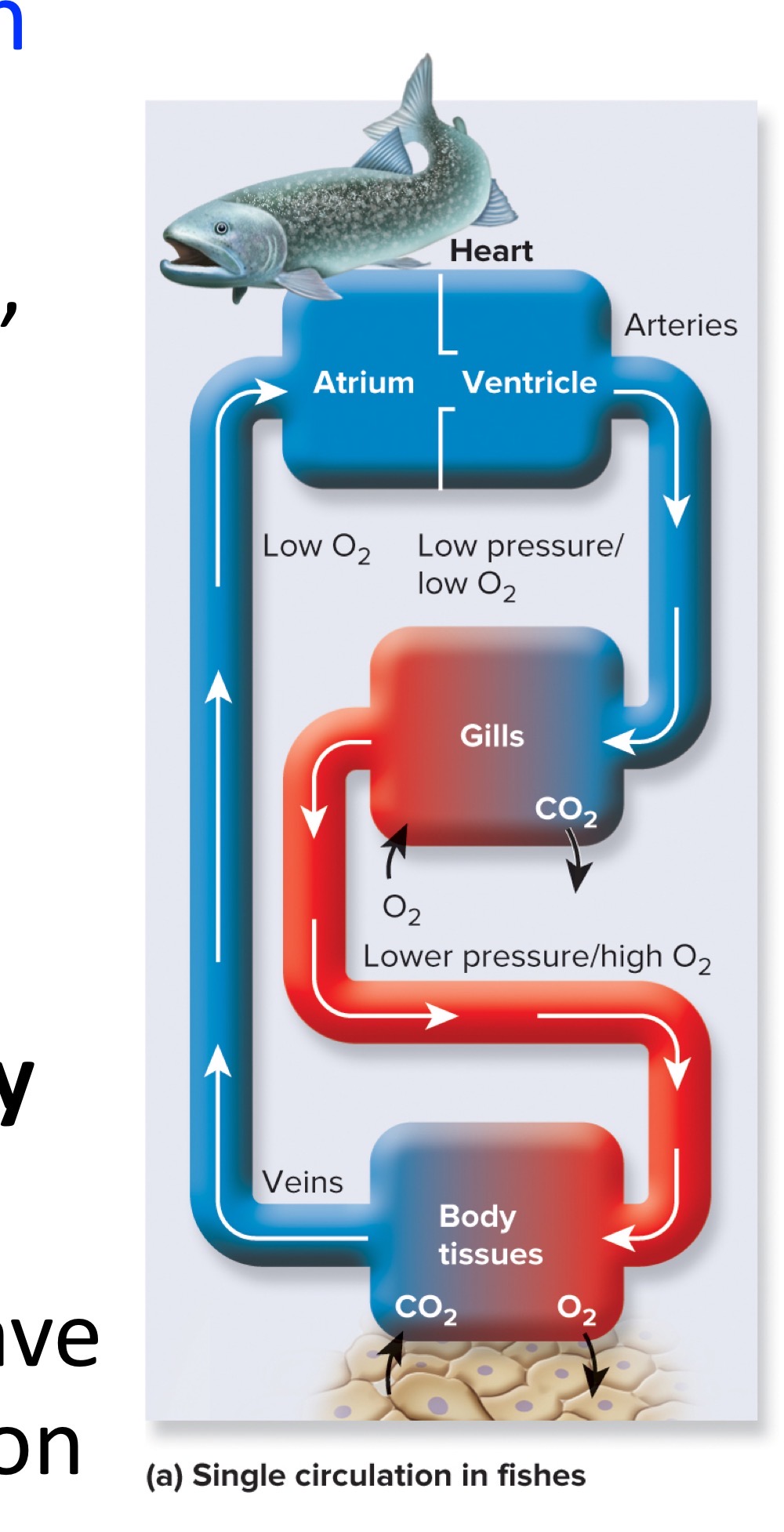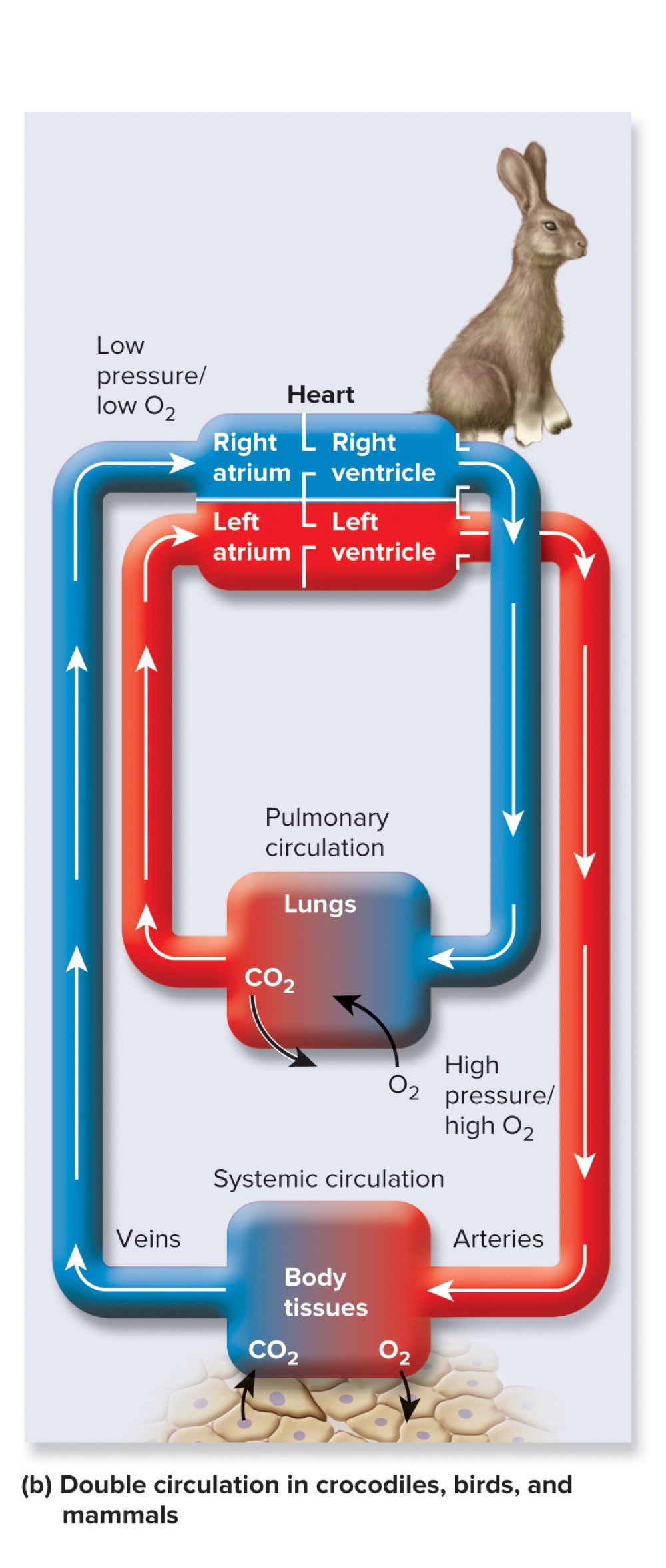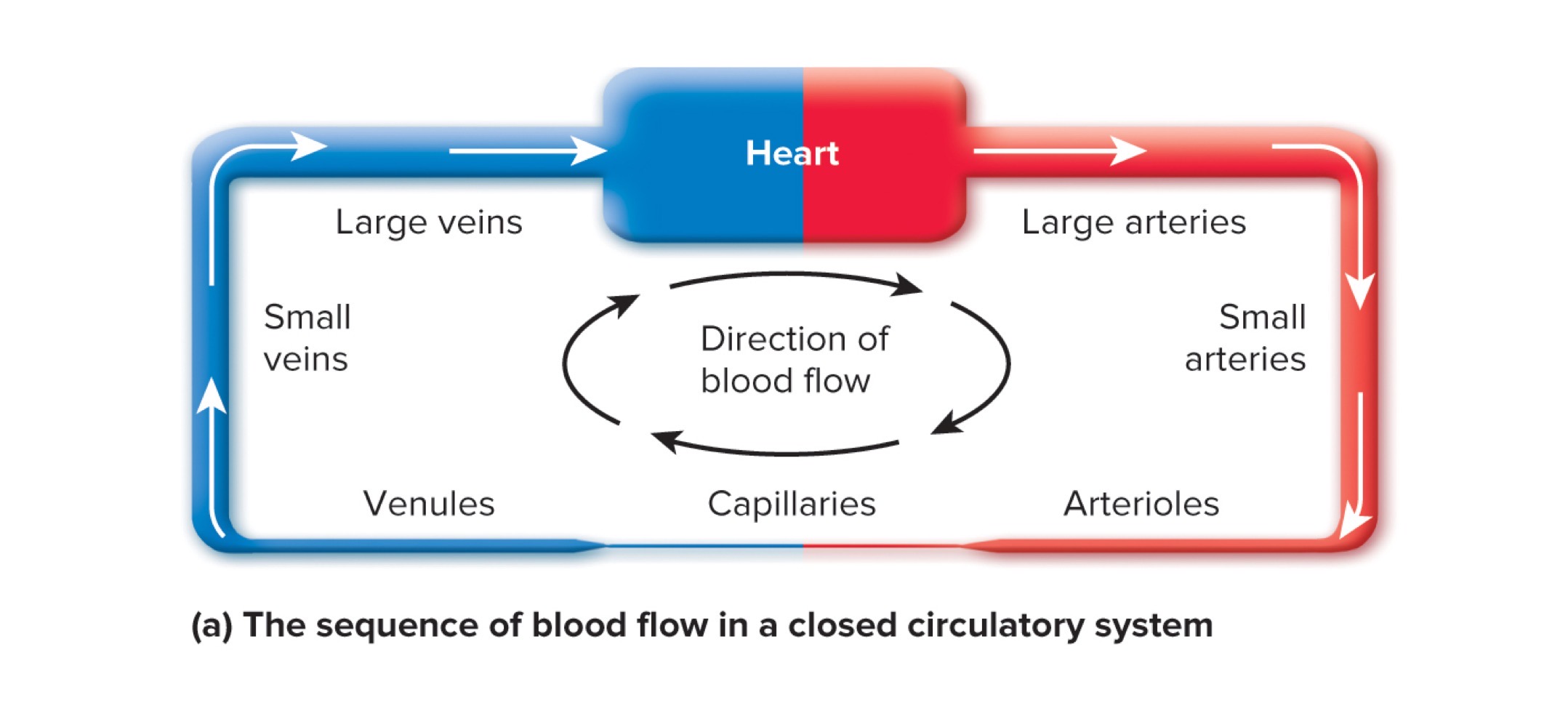BIOL 191A Unit 3
0.0(0)
0.0(0)
Card Sorting
1/263
There's no tags or description
Looks like no tags are added yet.
Study Analytics
Name | Mastery | Learn | Test | Matching | Spaced |
|---|
No study sessions yet.
264 Terms
1
New cards
All animals share similarities in how they…
1. exchange materials with their surroundings
2. obtain energy from organic nutrients
3. synthesize complex molecules
4. detect and respond to signals in their environment
5. reproduce themselces
2
New cards
4 types of animal tissues
1. muscle tissue
2. nervous tissue
3. epithelial tissue
4. connective tissue
3
New cards
muscle tissue
contain cells that are specialized to contract(shorten) which generates mechanical forces that may
* produce body movements(skeletal)
* decrease the diameter of a tube(smooth)
* exert pressure on a fluid-filled cavity(cardiac)
* produce body movements(skeletal)
* decrease the diameter of a tube(smooth)
* exert pressure on a fluid-filled cavity(cardiac)
4
New cards
nervous tissue
complex networks of neurons from one part of the body to another
* electrical signal produced in one neuron may
* stimulate or inhibit another neuron
* stimulate muscle cells to contract
* stimulate glandular cells to secrete their products(ex. sweat glands, digestive glands)
* electrical signal produced in one neuron may
* stimulate or inhibit another neuron
* stimulate muscle cells to contract
* stimulate glandular cells to secrete their products(ex. sweat glands, digestive glands)
5
New cards
neurons
cells that communicate by initiating and conducting electrical signals(action potentials) from one part of the body to another
6
New cards
epithelial tissues
sheets of densely packed cells that cover body surfaces, enclose organs, or line the walls of body cavities
* cells specialized for protection and transport
* asymmetrical(basal and apical surfaces)
* squamous, cuboidal, columnar
* tissues may be simple, stratified, pseudostratified, or transitional
* cells specialized for protection and transport
* asymmetrical(basal and apical surfaces)
* squamous, cuboidal, columnar
* tissues may be simple, stratified, pseudostratified, or transitional
7
New cards
connective tissues
diverse group of tissues that connect, surround, anchor, and support the structures of an animal’s body
* adipose tissue
* bone cartilage
* loose connective tissue
* dense connective tissue
* blood
* adipose tissue
* bone cartilage
* loose connective tissue
* dense connective tissue
* blood
8
New cards
high surface area/volume(SA/V) ratio
ideal for functions related to transport, absorption, or detection of environmental stimuli(ex. frog skin, human intestine)
9
New cards
homeostasis
process of maintaining relatively stable internal environment, despite changes in external surroundings
* fluctuations in air temp., water temp., nutrient availability, water availability, pH, and O2 availability occur in variable environments
* dynamic process
* fluctuations in air temp., water temp., nutrient availability, water availability, pH, and O2 availability occur in variable environments
* dynamic process
10
New cards
conformers
features of internal environment match external environment; restricted to stable environments; inexpensive
* ex. body fluids in a marine crab having same solute concentration, same w/ fish water temp.
* ex. body fluids in a marine crab having same solute concentration, same w/ fish water temp.
11
New cards
regulators
features of internal environment differ from external environment; expensive strategy
* ex. human body temp. regulation
* ex. human body temp. regulation
12
New cards
variables maintained within a normal range
1. concentrations of nutrients, wastes, and ions in the blood
2. concentration of O2 and CO2 in body fluids
3. pH of body fluids
4. blood pressure and blood volume
13
New cards
homeostatic control systems
1. decrease in body temp. disrupts homeostasis
2. **sensor** is typically group of neurons, such as temp. sensitive neurons in the skin
3. **integrator** located in brain and compares input from sensor w/ a **set point**
4. **effector** produces a response that compensates for change caused by homeostatic challenge
14
New cards
negative feedback loop
change in the variable being regulated brings about a response that moves the variable in the __opposite__ direction; maintains variable w/in normal range
15
New cards
positive feedback loop
accelerates a process; change in variable leads to events that __amplify__ that change; ex. blood clotting and uterine contractions
16
New cards
feedforward regulation
present in animals w/ well-developed nervous systems; animal’s body prepares for possible challenge to homeostasis
* ex. elevated heart rate prior to activity increase
* ex. elevated heart rate prior to activity increase
17
New cards
mammalian narrow range of body temperatures
resting body temperature: 35-38 degrees C
humans: body temp of 41 degrees C results in organ damage and temp of 42-43 degrees C is fatal
humans: body temp of 41 degrees C results in organ damage and temp of 42-43 degrees C is fatal
18
New cards
3 ways that temperature affects animals’ bodies
1. chemical reactions
1. inc. in body temp. speeds up reactions
2. low temp. makes it hard to carry out homeostasis
2. protein functions
1. high temps. can cause protein denaturing
3. membrane structure - think of it like ice
1. low temps. membranes too rigid(freezing)
2. high temps. membranes too fluid(melting)
1. both can disrupt membrane function
19
New cards
metabolic rate
amount of energy an organism uses in a given period of time to power its activities
* greater this is, more heat an animal generates
* calories used to quantify energy of metabolism
* greater this is, more heat an animal generates
* calories used to quantify energy of metabolism
20
New cards
basal metabolic rate(BMR)
most common measure used to compare metabolic rates of different species
* metabolic cost of living in a resting animal under controlled conditions
* metabolic cost of living in a resting animal under controlled conditions
21
New cards
endotherms
animals that generate their own internal heat through their metabolism
* require larger amounts of energy → food consumption
* risk of overheating during activity
* risk of loss of body fluids(esp. from evaporation due to cooling, sweating)
* require larger amounts of energy → food consumption
* risk of overheating during activity
* risk of loss of body fluids(esp. from evaporation due to cooling, sweating)
22
New cards
ectotherms
animals that rely on heat from the external environment to warm themselves
23
New cards
homeotherms
can maintain their body temp. w/in a narrow range
24
New cards
heterotherms
have body temps. that undergo considerable variations
25
New cards
heat exchange: radiation
emission of electromagnetic waves by the surface of objects; rate of emission determined by temp. of surface
* ex. heat from the sun radiates into the body, body heat radiates into air
* ex. heat from the sun radiates into the body, body heat radiates into air
26
New cards
heat exchange: evaporation
conversion of water from a liquid to a gaseous state; animals lose heat through evaporation of water from body surfaces
* heat is released by this due to sweating, panting
* heat is released by this due to sweating, panting
27
New cards
heat exchange: conduction
heat exchange through direct contact w/ other objects; greater temp. difference, greater rate of heat transfer
* ex. heat from body is transferred into cooler water
* ex. heat from body is transferred into cooler water
28
New cards
heat exchange: convection
transfer of heat by the movement of air or fluid next to the body
* ex. wind cools the body
* ex. wind cools the body
29
New cards
How can endotherms regulate how much heat is gained or lost between the environment and their bodies?
1. changes in skin blood flow
2. countercurrent exchange
3. evaporative heat loss
4. behavioral adaptations
30
New cards
endotherms: countercurrent exchange
heat is transferred between fluids flowing in opposite directions
* regulates heat loss by returning heat to body’s core and keeping core warmer than extremeties
* ex. warm blood travels down arteries in bird leg, heat moves by **conduction** to adjacent veins carrying cooler blood in the opposite directione
* regulates heat loss by returning heat to body’s core and keeping core warmer than extremeties
* ex. warm blood travels down arteries in bird leg, heat moves by **conduction** to adjacent veins carrying cooler blood in the opposite directione
31
New cards
endotherms: evaporative heat loss
regulated by changes in perspiration(for organisms w/ sweat glands) by panting
32
New cards
endotherms: behavioral adaptations
changing exposed body surface area(stretched out when hot; huddle when cold) and changing surroundings(seek shade, immerse in water when hot; stay in burrow when cold) THE BURROWING OWLS
33
New cards
types of changes in muscle activity for control of heat production in endotherms(staying warm when cold)
1. **shivering thermogenesis** - skeletal muscles contract rapidly without any locomotion; chem. reaction energy released as heat
2. nonshivering thermogenesis - heat production occurring in **brown adipose tissue**
1. uncoupling proteins modify mitochondria functions so energy of H+ gradient dissipated as heat(rather than energy for ATP synthesis)
34
New cards

intracellular fluid
water contained inside cells
* fluid inside little yellow ball cells in picture; little balls outside blood vessel
* fluid inside little yellow ball cells in picture; little balls outside blood vessel
35
New cards
extracellular fluid
primarily present as:
1. blood plasma - fluid flowing inside blood vessel around erythrocytes
2. interstitial fluid - fluid surrounding cells; yellow substance outside blood vessel
(these are separated by the walls of blood vessels)
1. blood plasma - fluid flowing inside blood vessel around erythrocytes
2. interstitial fluid - fluid surrounding cells; yellow substance outside blood vessel
(these are separated by the walls of blood vessels)
36
New cards
osmosis
allows water to move between fluid compartments in response to pressure differences
37
New cards
maintenance of normal body water levels is important for several reasons
1. water is solvent which aids dissolved solutes to participate in chemical reactions
2. water is transport vehicle the brings O2 and nutrients to cells and removes wastes generated by metabolism
1. dehydration compromises circulatory system and body temp. regulation
38
New cards
2 reasons ion balance is critical for cellular activites
1. muscle contraction
2. communication in nervous system
(can be compromised by dehydration; measured by **osmolarity)**
39
New cards
osmolarity
measure of solute concentration; value around 300 mOsm/L typical for animal body fluids
40
New cards
obligatory processes which have potential to disturb ion and water balance
1. eliminate nitrogenous wastes
2. obtain O2 and eliminate CO2
3. consume and metabolize food
4. regulate body temp.
(generally req. additional energy expenditure)
41
New cards
nitrogenous wastes
when proteins and nucleic acids are broken down in metabolized, these are generated; toxic in high concentrations and must be eliminated
42
New cards
respiration
in animals with lungs; associated w/ significant water loss
* why you might wake up dehydrated
* why you might wake up dehydrated
43
New cards
gills
water and ions can move across…
44
New cards
freshwater fish
* doesn’t drink water
* H2O enters gill capillaries by osmosis
* active uptake of Na+ and Cl- across gill epithelia into capilaries
* urine very dilute, copious containing very few ions
* osmolarity of water: 0-50 mOsm/L
takes in as much solutes as possible and excretes as much water as possible
* H2O enters gill capillaries by osmosis
* active uptake of Na+ and Cl- across gill epithelia into capilaries
* urine very dilute, copious containing very few ions
* osmolarity of water: 0-50 mOsm/L
takes in as much solutes as possible and excretes as much water as possible
45
New cards
saltwater fish
* drinks seawater
* H2O leaves gill capillaries and enters seawater by osmosis
* active excretion of Na+ and Cl- across gill epithelia
* small amount of concentrated urine containing large amounts of ions
* osmolarity of seawater: 1,000 mOsm/L
takes in as much water as possible and tries to excrete as much solutes as possible
* H2O leaves gill capillaries and enters seawater by osmosis
* active excretion of Na+ and Cl- across gill epithelia
* small amount of concentrated urine containing large amounts of ions
* osmolarity of seawater: 1,000 mOsm/L
takes in as much water as possible and tries to excrete as much solutes as possible
46
New cards
foods
contribute to ion and water balance; some water also created during metabolism
47
New cards
sweating and panting
in endotherms; used to cool the body, water lost from both, ion loss for one(think salty)
48
New cards
circulatory systems
transport necessary materials to all the cells to an animal’s body and transports wastes away from cells
49
New cards
open circulatory system
**hemolymph** fluid is pumped by one or more contractile hearts into the body cavity(**hemocoel**) of an animal
* metabolically inexpensive
* limits:
* inability to selectively deliver hemolymph to different tissues
* arthropods and some mollusks have this
* metabolically inexpensive
* limits:
* inability to selectively deliver hemolymph to different tissues
* arthropods and some mollusks have this
50
New cards
hemolymph
in open circulatory systems; fluid in blood vessels and the interstitial fluid that surrounds cells are __mixed__; this is the mixture
* nutrients and wastes are exchanged between this and cells(BUT O2 and CO2 are __not__ transported in this)
* returned through vessels or ostia to the heart
* nutrients and wastes are exchanged between this and cells(BUT O2 and CO2 are __not__ transported in this)
* returned through vessels or ostia to the heart
51
New cards
closed circulatory system
**blood** and **interstitial fluid** __separate__ and distinct; blood flows through **vessels**
* found in all earthworms, cephalopods, and all vertebrates
* distribution of blood flow can be adjusted to meet metabolic demands
* larger animals
* found in all earthworms, cephalopods, and all vertebrates
* distribution of blood flow can be adjusted to meet metabolic demands
* larger animals
52
New cards
blood
fluid connective tissues that contains a mixture of cells and solutes; transports nutrients, wastes, O2, and CO2; pressurized by one or more contractile hearts
* transport medium of animals with closed circulatory systems; moves all necessary materials to cells and takes away wastes
* components include:
* plasma
* leukocytes
* erythrocytes
* platelets
* transport medium of animals with closed circulatory systems; moves all necessary materials to cells and takes away wastes
* components include:
* plasma
* leukocytes
* erythrocytes
* platelets
53
New cards
plasma
composed of water, dissolved nutrients, ions, wastes, proteins, and gases; typically half total volume of blood
54
New cards
leukocytes(white blood cells)
protect and defend the body
55
New cards
erythrocytes(red blood cells)
transport O2
* contain large amounts of **hemoglobin**, reversibly binds O2(and CO2)
* in most vertebrates, mature retain nuclei, but in mammals, nuclei lost during maturation
* contain large amounts of **hemoglobin**, reversibly binds O2(and CO2)
* in most vertebrates, mature retain nuclei, but in mammals, nuclei lost during maturation
56
New cards
hemoglobin
large amounts in erythrocytes, reversibly binds O2(and CO2)
57
New cards
platelets
in vertebrate blood; cells/cell fragments that function in blood clot formation
* known as **thrombocytes** in other vertebrates
1. injury ruptures blood vessel
2. platelets stick to each other and to collagen fibers, forming a plug; blood loss reduced
3. fibrin forms meshwork which traps erythrocytes and platelets, forming clot that seals wounds
* known as **thrombocytes** in other vertebrates
1. injury ruptures blood vessel
2. platelets stick to each other and to collagen fibers, forming a plug; blood loss reduced
3. fibrin forms meshwork which traps erythrocytes and platelets, forming clot that seals wounds
58
New cards
arteries
carry blood away from a heart
59
New cards
veins
carry blood towards a heart
60
New cards
capillaries
sites of blood exchange
61
New cards
vertebrate circulatory systems(closed)
1. **single circulation** - in fishes
2. **double circulation** - in crocodiles, birds and mammals
62
New cards

single circulation
in fishes; heart has single filling chamber(atrium) and single exit chamber(ventricle)
63
New cards

double circulation
in crocodiles, birds, and mammals; heart has 4 chambers and 2 circuits of blood flow(**pulmonary** and **systemic circulation**)
64
New cards
septum
muscular wall that separates the two sides of the heart
65
New cards
blood flow through the heart
\*begin with deoxygenated blood
1. vena cava
2. right atrium
3. tricuspid valve(right atrioventricular valve)
4. right ventricle
5. pulmonary semilunar valve
6. pulmonary trunk → arteries
7. lungs → oxygenated blood
8. pulmonary veins
9. left atrium
10. bicuspid valve(left atrioventricular valve)
11. left ventricle
12. aortic semilunar valve
13. aorta → rest of body
1. vena cava
2. right atrium
3. tricuspid valve(right atrioventricular valve)
4. right ventricle
5. pulmonary semilunar valve
6. pulmonary trunk → arteries
7. lungs → oxygenated blood
8. pulmonary veins
9. left atrium
10. bicuspid valve(left atrioventricular valve)
11. left ventricle
12. aortic semilunar valve
13. aorta → rest of body
66
New cards
neurogenic heart(arthropods)
heart that ONLY beats when it receives impulses from the nervous system
67
New cards
myogenic heart(in vertebrates)
signaling mechanism that initiates contraction resides WITHIN the cardiac muscle itself
* nervous system can regulate rate and forcefulness of contraction
* nervous system can regulate rate and forcefulness of contraction
68
New cards
electrical excitation
leads to contraction in the heart beginning with the atria → ventricles
69
New cards
pacemaker
group of specialized cells that are located at the **sinoatrial(SA) node**
70
New cards
sinoatrial(SA) node
generates an electrical impulse beginning electrical excitation which spreads quickly across the atrial muscle to the **atrioventricular(AV) node**
71
New cards
atrioventricular(AV) node
receives electrical impulse form SA node during electrical excitation where it then conducts electrical signals from the atria to the ventricles
72
New cards
cardiac cycle
contraction and relaxation events that produce a single heartbeat; heart chambers progress through 2 phases during this
73
New cards
cardiac cycle phase: diastole
muscle is relaxed; chamber is filling
74
New cards
cardiac cycle phase: systole
muscle is contracting; chamber is emptying
75
New cards
process of the cardiac cycle
1. atrial systole
2. atrial systole ends, atrial diastole begins
3. ventricular systole - 1st phase
4. ventricular systole - 2nd phase
5. ventricular diastole - early
6. ventricular diastole - late
76
New cards
heart valves
open and close in response to pressure gradients; prevent backflow; makes sounds when they close(heartbeat)
77
New cards
blood pressure(P)
force exerted by the blood on the walls of the blood vessels; changes throughout the cardiac cycle, why blood pressure is measured w/ 2 numbers; drives blood flow
* highest during ventricular systole
* lowest during ventricular diastole
* typical healthy blood pressure in a human is around 120/80 mmHg(systolic/diastolic)
* highest during ventricular systole
* lowest during ventricular diastole
* typical healthy blood pressure in a human is around 120/80 mmHg(systolic/diastolic)
78
New cards
electrocardiogram(ECG or EKG)
overall recording of electrical impulses generated during the cardiac cycle
* reveals several waves of electrical excitation
* P wave
* QRS complex
* T wave
* reveals several waves of electrical excitation
* P wave
* QRS complex
* T wave
79
New cards
P wave
corresponds to atrial excitation
80
New cards
QRS complex
corresponds to ventricular excitation
81
New cards
T wave
corresponds to the reset of the ventricles back to their resting state
* tea is calm
* tea is calm
82
New cards

blood flow through blood vessels in a closed circulatory system
1. heart
2. larger arteries
3. small arteries
4. arterioles
5. capillaries
6. venules
7. small veins
8. large veins
9. heart
83
New cards
arteries
thick walled vessels that conduct blood __away__ from the heart
* contain many layers of smooth muscle and a slick inner lining called an **endothelieum**
* large ones often contain elastin fibers as well
* contain many layers of smooth muscle and a slick inner lining called an **endothelieum**
* large ones often contain elastin fibers as well
84
New cards
arterioles
smaller, branched arteries; composed of one or two layers of smooth muscle and connective tissue surrounding a layer of endothelium
* can **dilate** or **constrict** to control blood distribution to tissues
* can **dilate** or **constrict** to control blood distribution to tissues
85
New cards
capillaries
sites of exchange
* composed of single layer of endothelial cells, supported by a layer of extracellular matrix
* solutes readily diffuse between the blood in a capillary and the surrounding tissue
* composed of single layer of endothelial cells, supported by a layer of extracellular matrix
* solutes readily diffuse between the blood in a capillary and the surrounding tissue
86
New cards
capillary blood flow
pressure forces some fluid out of the blood at the beginning of the capillary; most fluid returned to blood at the venule-end of a capillary(lymphatic system collects excess interstitial fluid)
87
New cards
venules
small thin-walled vessels that carry blood away from the capillaries; empty into **veins** that return blood to the heart
88
New cards
veins
return blood to the heart
* walls of veins are thinner, less muscular, and more easily distorted than arteries; blood pressure is low
* walls of veins are thinner, less muscular, and more easily distorted than arteries; blood pressure is low
89
New cards
factors that assist blood flow through the veins
1. communication from the nervous system
2. skeletal muscle activity in limbs
3. valves
90
New cards
blood flow(F)
the movement of blood; blood pressure drives this
91
New cards
resistance(R)
impedes or slows blood flow; blood vessels are a source of resistance because because of the friction that occurs between blood and vessel walls
R = 1/r^4 so if the lumen of an arteriole increased by a factor of 2, then the resistance would DECREASE by a factor of 16(2^4)
R = 1/r^4 so if the lumen of an arteriole increased by a factor of 2, then the resistance would DECREASE by a factor of 16(2^4)
92
New cards
blood flow(F) equation
Flow(F) = change in pressure(P)/resistance(R)
or change in P = F X R
* blood flow is directly proportional to difference in pressure(between. the beginning and end of the vessel/circuit)
* inversely proportional to the resistance
or change in P = F X R
* blood flow is directly proportional to difference in pressure(between. the beginning and end of the vessel/circuit)
* inversely proportional to the resistance
93
New cards
radius of arterioles
can be changed to regulate resistance and the activity of the heart can be changed to regulate flow
94
New cards
vasodilation
increase in radius
95
New cards
vasoconstriction
decrease in radius
96
New cards
cardiac output
amount of blood the heart pumps per unit of time and is typically expressed in L/min
* determined by 2 parameters: heart rate(beats/min) and stroke volume(mL/beat)
* CO = SV x HR
* determined by 2 parameters: heart rate(beats/min) and stroke volume(mL/beat)
* CO = SV x HR
97
New cards
Poiseuille’s law
expresses the relationship between flow, pressure, and resistance can be adapted to the whole body:
* BP = CO x TPR
* BP - arterial blood pressure
* CO - cardiac output(flow)
* TRP - total peripheral resistance
* BP = CO x TPR
* BP - arterial blood pressure
* CO - cardiac output(flow)
* TRP - total peripheral resistance
98
New cards
arterial blood pressure
function of how hard the heart is working and how constricted or dilated the various arterioles are
99
New cards
air composition
* 78% nitrogen
* 21% oxygen
* 1% carbon dioxide
* other gases
* 21% oxygen
* 1% carbon dioxide
* other gases
100
New cards
partial pressure
of a gas provides the driving air force for its diffusion; all gases diffuse from regions of higher pressure → lower pressure
* individual pressure exerted by each gas, which is exactly proportional to its amount in the mixture
* individual pressure exerted by each gas, which is exactly proportional to its amount in the mixture